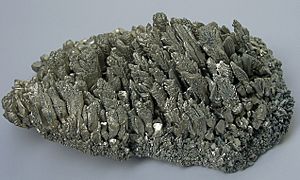Magnesium facts for kids
 |
||||||||||||||||||||||||
| Magnesium | ||||||||||||||||||||||||
|---|---|---|---|---|---|---|---|---|---|---|---|---|---|---|---|---|---|---|---|---|---|---|---|---|
| Pronunciation | /mæɡˈniːziəm/ |
|||||||||||||||||||||||
| Appearance | shiny grey solid | |||||||||||||||||||||||
| Standard atomic weight Ar, std(Mg) | [24.304, 24.307] conventional: 24.305 | |||||||||||||||||||||||
| Magnesium in the periodic table | ||||||||||||||||||||||||
|
||||||||||||||||||||||||
| Atomic number (Z) | 12 | |||||||||||||||||||||||
| Group | group 2 (alkaline earth metals) | |||||||||||||||||||||||
| Period | period 3 | |||||||||||||||||||||||
| Block | s | |||||||||||||||||||||||
| Electron configuration | [Ne] 3s2 | |||||||||||||||||||||||
| Electrons per shell | 2, 8, 2 | |||||||||||||||||||||||
| Physical properties | ||||||||||||||||||||||||
| Phase at STP | solid | |||||||||||||||||||||||
| Melting point | 923 K (650 °C, 1202 °F) | |||||||||||||||||||||||
| Boiling point | 1363 K (1091 °C, 1994 °F) | |||||||||||||||||||||||
| Density (near r.t.) | 1.738 g/cm3 | |||||||||||||||||||||||
| when liquid (at m.p.) | 1.584 g/cm3 | |||||||||||||||||||||||
| Heat of fusion | 8.48 kJ/mol | |||||||||||||||||||||||
| Heat of vaporization | 128 kJ/mol | |||||||||||||||||||||||
| Molar heat capacity | 24.869 J/(mol·K) | |||||||||||||||||||||||
Vapor pressure
|
||||||||||||||||||||||||
| Atomic properties | ||||||||||||||||||||||||
| Oxidation states | +1, +2 (a strongly basic oxide) | |||||||||||||||||||||||
| Electronegativity | Pauling scale: 1.31 | |||||||||||||||||||||||
| Ionization energies |
|
|||||||||||||||||||||||
| Atomic radius | empirical: 160 pm | |||||||||||||||||||||||
| Covalent radius | 141±7 pm | |||||||||||||||||||||||
| Van der Waals radius | 173 pm | |||||||||||||||||||||||
| Spectral lines of magnesium | ||||||||||||||||||||||||
| Other properties | ||||||||||||||||||||||||
| Natural occurrence | primordial | |||||||||||||||||||||||
| Crystal structure | hexagonal close-packed (hcp) | |||||||||||||||||||||||
| Speed of sound thin rod | (annealed) 4940 m/s (at r.t.) |
|||||||||||||||||||||||
| Thermal expansion | 24.8 µm/(m⋅K) (at 25 °C) | |||||||||||||||||||||||
| Thermal conductivity | 156 W/(m⋅K) | |||||||||||||||||||||||
| Electrical resistivity | 43.9 n Ω⋅m (at 20 °C) | |||||||||||||||||||||||
| Magnetic ordering | paramagnetic | |||||||||||||||||||||||
| Young's modulus | 45 GPa | |||||||||||||||||||||||
| Shear modulus | 17 GPa | |||||||||||||||||||||||
| Bulk modulus | 45 GPa | |||||||||||||||||||||||
| Poisson ratio | 0.290 | |||||||||||||||||||||||
| Mohs hardness | 2.5 | |||||||||||||||||||||||
| Brinell hardness | 260 MPa | |||||||||||||||||||||||
| CAS Number | 7439-95-4 | |||||||||||||||||||||||
| History | ||||||||||||||||||||||||
| Discovery | Joseph Black (1755) | |||||||||||||||||||||||
| First isolation | Humphry Davy (1808) | |||||||||||||||||||||||
| Main isotopes of magnesium | ||||||||||||||||||||||||
|
||||||||||||||||||||||||
Magnesium (pronounced mag-NEE-zee-əm) is a chemical element. Its symbol is Mg and its atomic number is 12. It is a type of metal called an alkaline earth metal.
Magnesium is very common. It is the eighth most abundant element in the Earth's crust, making up about 2% of its weight. It is also the ninth most common element in the entire universe. This is because magnesium is easily formed inside giant stars that explode, known as supernovas.
Magnesium ions (which are atoms with an electrical charge) dissolve very well in water. This makes magnesium the third most common element found dissolved in seawater.
Contents
Why is Magnesium Important for Life?
Magnesium is the 11th most common element by weight in the human body. Its ions are vital for all living cells to work properly. These ions help manage important biological compounds like ATP (which gives cells energy), DNA, and RNA.
Many enzymes (special proteins that help chemical reactions happen) need magnesium ions to do their job. Magnesium is also the metal found at the center of chlorophyll, which is the green pigment that helps plants make their own food using sunlight. Because of this, magnesium is often added to fertilizers to help plants grow.
Magnesium ions can taste a bit sour. In small amounts, they give a natural tartness to fresh mineral waters.
How Do We Get Magnesium?
You won't find pure magnesium metal naturally on Earth. This is because it is very reactive, meaning it easily combines with other elements. However, once the metal is made, it gets covered with a thin layer of oxide. This layer helps protect it and makes it less reactive.
Pure magnesium metal burns with a very bright white light. This makes it useful in things like flares and fireworks. Today, most magnesium metal is made by a process called electrolysis. This involves using electricity to separate magnesium from its salts, which are often taken from salty water (brine).
What is Magnesium Used For?
Magnesium is a very useful metal. Its main use is to be mixed with other metals to create strong, lightweight materials.
Strong and Light Alloys
One of the most common uses for magnesium is mixing it with aluminium. These mixtures are called "magnalium" or "magnelium." Since magnesium is lighter than aluminium, these alloys are valued for being both light and strong. They are used to make parts for things like bicycle frames and car engines.
Everyday Uses
Magnesium is used in fireworks to create a brilliant white light when it burns. It can also be found in many electronic devices.
Magnesium in Electronics
Because it is light and has good electrical properties, magnesium is used in:
- mobile phones
- laptop computers
- cameras
- Other electronic parts
Magnesium in Medicine
Magnesium compounds are also used in medicine. They can be found in common laxatives (to help with digestion) and antacids (like milk of magnesia, which helps with stomach upset). Magnesium is also used in situations where doctors need to calm overactive nerves or relax blood vessels.
Other Pages
Images for kids
See also
 In Spanish: Magnesio para niños
In Spanish: Magnesio para niños









